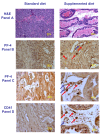Micronutrients attenuate progression of prostate cancer by elevating the endogenous inhibitor of angiogenesis, platelet factor-4
- PMID: 20525356
- PMCID: PMC2896361
- DOI: 10.1186/1471-2407-10-258
Micronutrients attenuate progression of prostate cancer by elevating the endogenous inhibitor of angiogenesis, platelet factor-4
Abstract
Background: Longstanding evidence implicates an inadequate diet as a key factor in the onset and progression of prostate cancer. The purpose herein was to discover, validate and characterize functional biomarkers of dietary supplementation capable of suppressing the course of prostate cancer in vivo.
Methods: The Lady transgenic mouse model that spontaneously develops prostate cancer received a diet supplemented with a micronutrient cocktail of vitamin E, selenium and lycopene ad libitum. A proteomic analysis was conducted to screen for serum biomarkers of this dietary supplementation. Candidate peptides were validated and identified by sequencing and analyzed for their presence within the prostates of all mice by immunohistochemistry.
Results: Dietary supplementation with the combined micronutrients significantly induced the expression of the megakaryocyte-specific inhibitor of angiogenesis, platelet factor-4 (P = 0.0025). This observation was made predominantly in mice lacking tumors and any manifestations associated with progressive disease beyond 37 weeks of life, at which time no survivors remained in the control group (P < 0.0001). While prostates of mice receiving standard chow were enlarged and burdened with poorly differentiated carcinoma, those of mice on the supplemented diet appeared normal. Immunohistochemical analysis revealed marked amplifications of both platelet binding and platelet factor-4 within the blood vessels of prostates from mice receiving micronutrients only.
Conclusion: We present unprecedented data whereby these combined micronutrients effectively promotes tumor dormancy in early prostate cancer, following initiation mutations that may drive the angiogenesis-dependent response of the tumor, by inducing platelet factor-4 expression and concentrating it at the tumor endothelium through enhanced platelet binding.
Figures



Similar articles
-
Dietary lycopene, angiogenesis, and prostate cancer: a prospective study in the prostate-specific antigen era.J Natl Cancer Inst. 2014 Feb;106(2):djt430. doi: 10.1093/jnci/djt430. Epub 2014 Jan 24. J Natl Cancer Inst. 2014. PMID: 24463248 Free PMC article.
-
Antioxidants block prostate cancer in lady transgenic mice.Cancer Res. 2004 Aug 15;64(16):5891-6. doi: 10.1158/0008-5472.CAN-04-0690. Cancer Res. 2004. PMID: 15313934
-
A combination of micronutrients is beneficial in reducing the incidence of prostate cancer and increasing survival in the Lady transgenic model.Cancer Prev Res (Phila). 2009 May;2(5):473-83. doi: 10.1158/1940-6207.CAPR-08-0124. Epub 2009 Apr 28. Cancer Prev Res (Phila). 2009. PMID: 19401531
-
Prevention of prostate cancer.Hematol Oncol Clin North Am. 2001 Jun;15(3):445-57. doi: 10.1016/s0889-8588(05)70225-2. Hematol Oncol Clin North Am. 2001. PMID: 11525290 Review.
-
Selenium and prostate cancer prevention: insights from the selenium and vitamin E cancer prevention trial (SELECT).Nutrients. 2013 Apr 3;5(4):1122-48. doi: 10.3390/nu5041122. Nutrients. 2013. PMID: 23552052 Free PMC article. Review.
Cited by
-
Recent Progress in Discovering the Role of Carotenoids and Their Metabolites in Prostatic Physiology and Pathology with a Focus on Prostate Cancer-A Review-Part I: Molecular Mechanisms of Carotenoid Action.Antioxidants (Basel). 2021 Apr 10;10(4):585. doi: 10.3390/antiox10040585. Antioxidants (Basel). 2021. PMID: 33920256 Free PMC article. Review.
-
Selenium in Prostate Cancer: Prevention, Progression, and Treatment.Pharmaceuticals (Basel). 2023 Sep 5;16(9):1250. doi: 10.3390/ph16091250. Pharmaceuticals (Basel). 2023. PMID: 37765058 Free PMC article. Review.
-
Influence of concurrent medications on outcomes of men with prostate cancer included in the TAX 327 study.Can Urol Assoc J. 2013 Jan-Feb;7(1-2):E74-81. doi: 10.5489/cuaj.267. Can Urol Assoc J. 2013. PMID: 23671512 Free PMC article.
-
Tomatoes, Lycopene, and Prostate Cancer: What Have We Learned from Experimental Models?J Nutr. 2022 Jun 9;152(6):1381-1403. doi: 10.1093/jn/nxac066. J Nutr. 2022. PMID: 35278075 Free PMC article. Review.
-
Selenium and vitamin E for prostate cancer: post-SELECT (Selenium and Vitamin E Cancer Prevention Trial) status.Mol Med. 2011 Jan-Feb;17(1-2):134-43. doi: 10.2119/molmed.2010.00136. Epub 2010 Sep 21. Mol Med. 2011. PMID: 20882260 Free PMC article. Review.
References
-
- Colli JL, Amling CL. Exploring causes for declining prostate cancer mortality rates in the United States. Urol Oncol. 2008;26(6):627–633. - PubMed
-
- Venkateswaran V, Klotz LH, Ramani M, Sugar LM, Jacob LE, Nam RK, Fleshner. A combination of micronutrients is beneficial in reducing the incidence of prostate cancer and increasing survival in the Lady transgenic model. Cancer Prevention Research. 2009;2(5):473–483. doi: 10.1158/1940-6207.CAPR-08-0124. - DOI - PubMed
-
- Schonberg S, Krokan HE. The inhibitory effects of conjugated dienoic derivatives of linoleic acid on the growth of human tumor cells lines is in part due to increased lipid peroxidation. Anticancer Res. 1995;15:1241–1246. - PubMed
Publication types
MeSH terms
Substances
LinkOut - more resources
Full Text Sources
Medical

